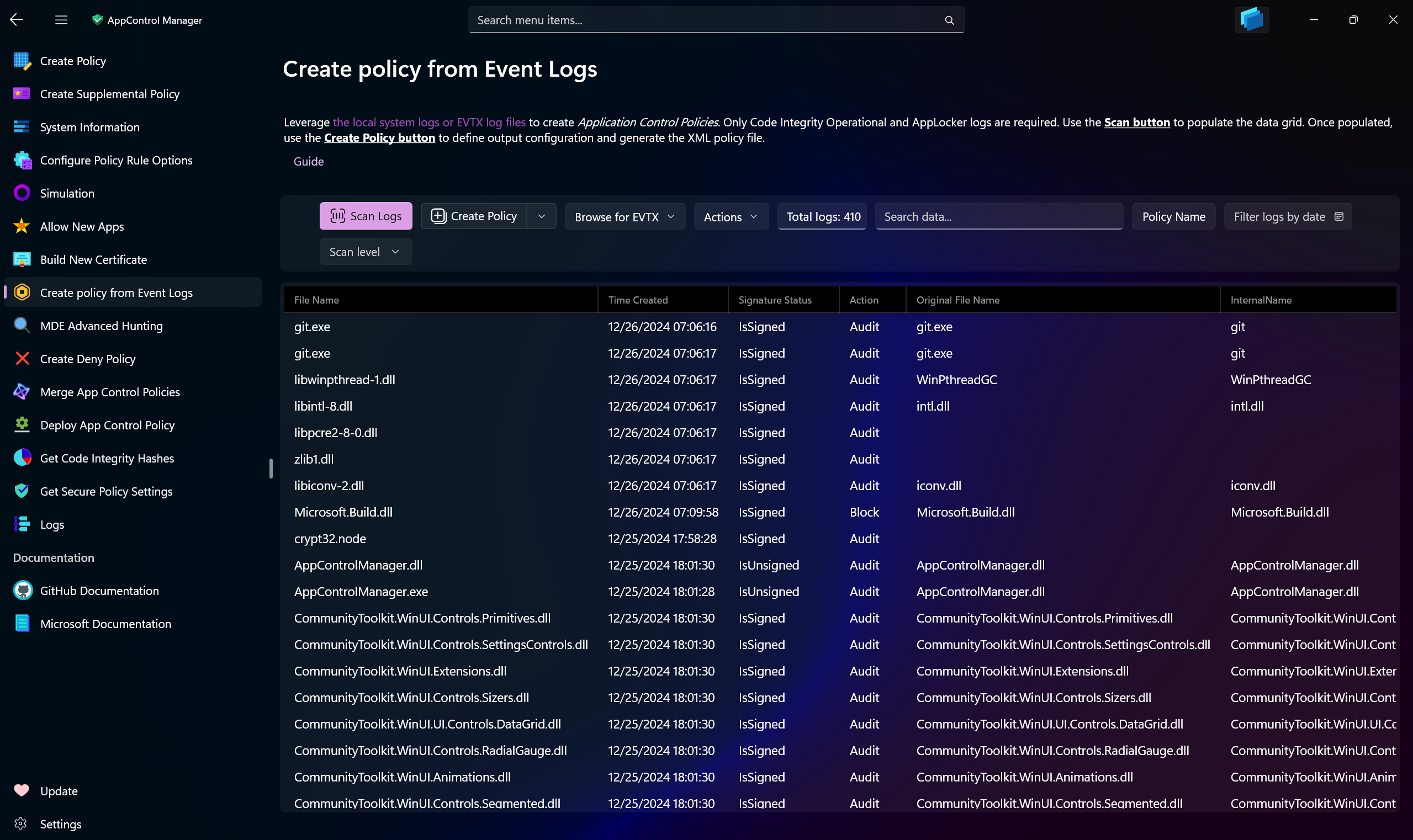-
-
Notifications
You must be signed in to change notification settings - Fork 237
Create Policy From Event Logs

This page in AppControl Manager allows you to create Application Control policies directly from local event logs or EVTX files. It focuses on processing Code Integrity and AppLocker event logs to help build tailored policies.
This page offers a data grid that has search functionality, sorting, removal of individual logs and copying entire rows or each cell to the clipboard.
-
Scan Logs: Click this button to initiate a scan of the system for relevant Code Integrity and AppLocker events and display them in the page.
-
Browse for EVTX: Use this option to browse for Code Integrity and/or AppLocker exported EVTX log files. When EVTX log files are selected, pressing the Scan Logs button will scan those instead of the system logs.
-
Create Policy -> Add to policy: Use this option to select an existing Application Control XML policy file. The events you choose will be added directly to this file, expanding its coverage.
-
Create Policy -> Base policy file: This option allows you to specify a base XML policy file. The supplemental policy generated from the event logs will be linked to this base policy.
-
Create Policy -> Base GUID: Enter the GUID of an existing base policy here. The supplemental policy created from the event logs will be associated with this specified GUID.
-
Policy Name: Enter the name of the policy that will be created from the event logs.
-
Filters logs by date: Use the calendar to filter the logs based on date they were generated.
-
Deploy policy after creation: Use this toggle button to tell the application that you want to deploy the policy after creation.
-
Scan Level: You can choose from different scan levels. Refer to this page for all the information about them.
-
Only Use Selected Items: If this button is toggled, only the items in the List View that are highlighted will be added to the Supplemental policy. If this button is not toggled, then everything available in the List View will be added to the Supplemental policy.
- Create AppControl Policy
- Create Supplemental Policy
- System Information
- Configure Policy Rule Options
- Policy Editor
- Simulation
- Allow New Apps
- Build New Certificate
- Create Policy From Event Logs
- Create Policy From MDE Advanced Hunting
- Create Deny Policy
- Merge App Control Policies
- Deploy App Control Policy
- Get Code Integrity Hashes
- Get Secure Policy Settings
- Update
- Sidebar
- Validate Policies
- View File Certificates
- Microsoft Graph
- Protect
- Microsoft Security Baselines
- Microsoft Security Baselines Overrides
- Microsoft 365 Apps Security Baseline
- Microsoft Defender
- Attack Surface Reduction
- Bitlocker
- Device Guard
- TLS Security
- Lock Screen
- User Account Control
- Windows Firewall
- Optional Windows Features
- Windows Networking
- Miscellaneous Configurations
- Windows Update
- Edge Browser
- Certificate Checking
- Country IP Blocking
- Non Admin Measures
- Group Policy Editor
- Manage Installed Apps
- File Reputation
- Audit Policies
- Cryptographic Bill of Materials
- Introduction
- How To Generate Audit Logs via App Control Policies
- How To Create an App Control Supplemental Policy
- The Strength of Signed App Control Policies
- How To Upload App Control Policies To Intune Using AppControl Manager
- How To Create and Maintain Strict Kernel‐Mode App Control Policy
- How to Create an App Control Deny Policy
- App Control Notes
- How to use Windows Server to Create App Control Code Signing Certificate
- Fast and Automatic Microsoft Recommended Driver Block Rules updates
- App Control policy for BYOVD Kernel mode only protection
- EKUs in App Control for Business Policies
- App Control Rule Levels Comparison and Guide
- Script Enforcement and PowerShell Constrained Language Mode in App Control Policies
- How to Use Microsoft Defender for Endpoint Advanced Hunting With App Control
- App Control Frequently Asked Questions (FAQs)
- System Integrity Policy Transformations | XML to CIP and Back
- About Code Integrity Policy Signing
- Create Bootable USB flash drive with no 3rd party tools
- Event Viewer
- Group Policy
- How to compact your OS and free up extra space
- Hyper V
- Git GitHub Desktop and Mandatory ASLR
- Signed and Verified commits with GitHub desktop
- About TLS, DNS, Encryption and OPSEC concepts
- Things to do when clean installing Windows
- Comparison of security benchmarks
- BitLocker, TPM and Pluton | What Are They and How Do They Work
- How to Detect Changes in User and Local Machine Certificate Stores in Real Time Using PowerShell
- Cloning Personal and Enterprise Repositories Using GitHub Desktop
- Only a Small Portion of The Windows OS Security Apparatus
- Rethinking Trust: Advanced Security Measures for High‐Stakes Systems
- Clean Source principle, Azure and Privileged Access Workstations
- How to Securely Connect to Azure VMs and Use RDP
- Basic PowerShell tricks and notes
- Basic PowerShell tricks and notes Part 2
- Basic PowerShell tricks and notes Part 3
- Basic PowerShell tricks and notes Part 4
- Basic PowerShell tricks and notes Part 5
- How To Access All Stream Outputs From Thread Jobs In PowerShell In Real Time
- PowerShell Best Practices To Follow When Coding
- How To Asynchronously Access All Stream Outputs From Background Jobs In PowerShell
- Powershell Dynamic Parameters and How to Add Them to the Get‐Help Syntax
- RunSpaces In PowerShell
- How To Use Reflection And Prevent Using Internal & Private C# Methods in PowerShell
